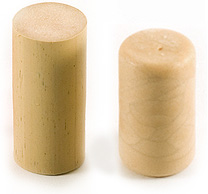 In part I of this two part series, we talked about the two major ways that synthetic corks are produced. In today’s post I would like to continue those thoughts and go over the significance these two production methods have on the resulting synthetic corks and in what way these corks affect the wine they are sealing.
In part I of this two part series, we talked about the two major ways that synthetic corks are produced. In today’s post I would like to continue those thoughts and go over the significance these two production methods have on the resulting synthetic corks and in what way these corks affect the wine they are sealing.
As stated before, with the extrusion method the synthetic corks’ inner elastic foam is exposed on either end of the cork. With injection molded synthetic corks none of the inner elastic foam is exposed. The elastic foam is completely sealed by its outer shell.
With extruded corks, absorption of wine into the elastic foam may be an issue. Foam of this type provides an incredible amount of surface area to come in contact with the wine as it is drawn into to the cork. Over time this may lead to the transfer off-flavors from the cork to the wine. The jury is still out on this issue. We’ll have to wait to see.
Some extruded synthetic corks can have slightly frayed corners because they are cut from a longer extruded piece. This fraying can cause a bottle of wine to have a plastic flake in it every now and then. Again, injection molded synthetic corks do not have this issue because they are not cut in anyway and there are no Sharp edges.
Some extruded corks have had a chamfer ground into its cut edge. This eliminates the fray and make them easier to extract when it is time to decant the bottle. If you do decide to by extruded synthetic corks, these are the kind we would suggest.
Just from a general aesthetic view, injection molded corks look closer to a natural cork than their extruded counterparts. Except for their size, extruded corks don’t really look anything like a natural wine cork.
For these reasons, if you decide to go with the synthetic when it comes time to buy corks, we recommend that you purchase injection molded synthetic corks as opposed to extruded corks. The cost is about the same, and you’ll get a better cork.
The is part II of a two part series. Read How Are Synthetic Corks Made? (Part I) here.
———————————————————————————————————
Ed Kraus is a 3rd generation home brewer/winemaker and has been an owner of E. C. Kraus since 1999. He has been helping individuals make better wine and beer for over 25 years.
